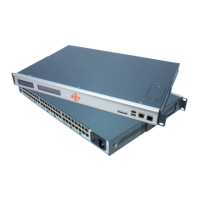8: Device Ports
SLC™ 8000 Advanced Console Manager User Guide 130
Modem Settings (Device Ports)
Note: Depending on the State and Mode you select, different fields are available.
USB VBUS For USB Device Ports only. If enabled, the USB VBUS signal provides power to
the USB device attached to a device port. Disabling VBUS will power down the
device as long as it is bus-powered instead of self-powered. The VBUS 5V signal
is up to 100 mA per port, but not to exceed 600mA total per USB I/O Module.
Drawing more than 150 mA on a USB port will shut down the VBUS 5V.
Caution: USB ports are designed for data traffic only. They are not
designed for charging or powering devices. Over-current conditions on
VBUS 5V may disrupt operations.
State Used if an external modem is attached to the device port. If enabling, set the
modem to dial-out, dial-in, dial-back, dial-on-demand, dial-in/host list, dial-back &
dial-on-demand, dial in & dial-on-demand, CBCP Server, and CBCP Client.
Disabled by default. See Modem Dialing States (on page 178) for more
information.
Mode The format in which the data flows back and forth:
Text: In this mode, the SLC advanced console manager assumes that the
modem will be used for remotely logging into the command line. Text mode
can only be used for dialing in or dialing back. Text is the default.
PPP: This mode establishes an IP-based link over the modem. PPP
connections can be used in dial-out mode (e.g., the SLC unit connects to an
external network), dial-in mode (e.g., the external computer connects to the
network that the SLC 8000 advanced console manager is part of), or dial-on-
demand.
Use Sites Enables the use of site-oriented modem parameters which can be activated by
various modem-related events (authentication, outbound network traffic for dial-
on-demand connections, etc.). Sites can be used with the following modem
states: dial-in, dial-back, dial-on-demand, dial-in & dial-on-demand, dial-back &
dial-on-demand, and CBCP server.
Initialization Script Commands sent to configure the modem may have up to 100 characters. Consult
your modem’s documentation for recommended initialization options. If you do
not specify an initialization script, the SLC unit uses a default initialization string of
AT S7=45 SO=0 L1 V1 X4 &D2 &c1 E1 Q0.
Note: We recommend that the modem initialization script always be preceded
with AT and include E1 V1 x4 Q0 so that the SLC 8000 advanced console
manager may properly control the modem. For information on AT commands,
refer to the modem user guide, or do a web search for at command set.
Serial modems may need to include &B1 in the modem initialization string to set
the DTE rate to a fixed baud rate.
Modem Timeout
Timeout for all modem connections. Select Yes (default) for the SLC unit to
terminate the connection if no traffic is received during the configured idle time.
Enter a value of from 1 to 9999 seconds. The default is 30 seconds.
Caller ID Logging Select to enable the SLC advanced console manager to log caller IDs on
incoming calls. Disabled by default.
Note: For the Caller ID AT command, refer to the modem user guide.
Modem Command
Modem
AT command used to initiate caller ID logging by the modem.
Note: For the AT command, refer to the modem user guide.

